"Everlastingly At It!": Viewing the Turn of the (Last) Century from the BGC Archives
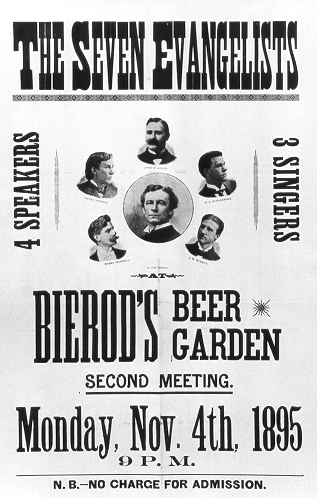
Poster for meeting held in St. Louis. B. Fay Mills in the center of the portraits, William Biederwolf is in the 2 o'clock position. From Collection 195
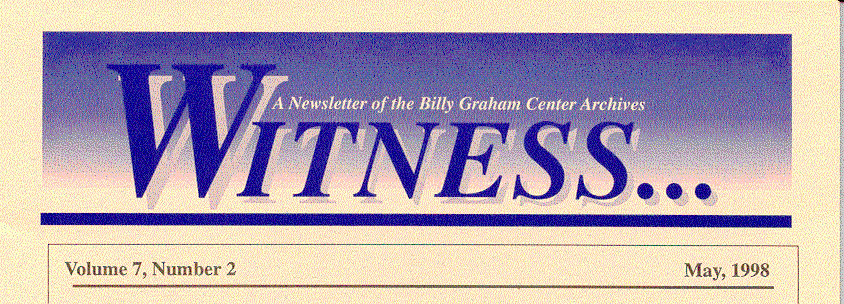
Guides that describe in detail the collections mentioned in this newsletter can accessed through the Archives web site at the Collections page

Poster for meeting held in St. Louis. B. Fay Mills in the center of the portraits, William Biederwolf is in the 2 o'clock position. From Collection 195
As the year 2000 approaches, individuals are
planning their celebrations, companies look for merchandizing
tie-ins, and programmers try to work out ways to deflect the
worst effects of the Millennium Bug. It is interesting, while
we consider how crossing this invisible,
artificial dividing line will effect us, to consider the
last time the human race crossed a major chronological
border, the entry into the twentieth century, the decade from 1895
to 1905. In this issue of Witness... we will
look at samples of the Archives' holdings from that era.
The documents in the Archives' collections are almost
wholly twentieth century (except for microfilm) and except for a
few atypical items, the 1890s would represent just about the
farthest point our collections will allow our
patrons to reach back in time. The 1890s was at
the beginning of a great surge of Protestant nondenominational effort that continues in many ways to
this day. Under the impetus of the examples of men like
evangelist Dwight L. Moody and China Inland Mission founder
J. Hudson Taylor, parachurch organizations were starting
to spring up to organize efforts to win converts and
build Christian communities of faith all over the world, especially
in the United States.
The collections also, inevitably, document
other facets of Christian life, such as styles of worship and the
way individuals applied their faith in (or reconciled it to)
their daily lives.
Individuals and organizations of the time were
engaged in a wide variety of ways to spread the gospel and some
of that variety is reflected in the Archives collections. In
1895, Dwight L. Moody was considered the leading evangelist
in the country. The Archives does not have very much
material from Moody, but there are some odds and ends, such as
(in Collection 318) the 1897 letter to his daughter-in-law on
the occasion of the birth of his first grandson. (Click
here to go to the portion of the Archives web site where several of
Moody's letters, along with transcripts, are available.) At the same time Moody was writing
his letter, the leading American evangelist of the next generation, Billy Sunday,
was beginning to lead his own campaigns in small towns in Iowa. Collection
61 contains endorsements, letters and other reports about
his early efforts.
Documentation of the vigor of other preachers of
the period, and the ways "union"
evangelistic meetings were organized to make an impact on
communities, can be found in the sermons, scrapbooks and
other records of such men as John Wilbur Chapman (Collection 177), William
Bell Riley (Collection 95) and William Biederwolf (Collection 195).
Biederwolf's collection is particularly valuable, since it contains scrapbooks with reports
on the work of other evangelists. Mass evangelism campaigns
were two-edged swords in many cities and these and other collections
also document the controversies they raised.
It was also a time of specialized ministries. Mel Trotter was
an alcoholic whose life turned around when he gave his life to Christ.
Collection 47 documents his founding in 1900 of a rescue mission
in Grand Rapids, Michigan, that became the first of dozens he started
or influenced around the country. The motto of the mission could
have served as that for many other ministries of the time, "Everlastingly
at it!" Reports on converts, sermons, and statistics are among the
materials that describe the beginnings of the mission outreach to the
poor, homeless, sick and destitute. To quote from the mission's 1905
report, "A glimpse into the [mission's] store-room on distribution day
would make glad the heart of the generous donators and a look into some
of the homes which were thus made happy would bring tears to the
eyes and a great sorrow to know that such misery and destitution could
exist in a Christian land and a civilized, progressive city like Grand
Rapids."
William Eugene Blackstone (Collection 540), a
self-educated building and property investor, founded the Chicago Hebrew Mission
in 1891. He was dedicated to presenting
the gospel to the Jewish community, so that as many as would would accept Jesus
as the Messiah. His efforts are reflected in his files, which includes
correspondence with Jewish leaders, petitions to
the President of the United States seeking a homeland in Palestine for displaced
Jews, and reports on evangelistic outreach in the United States, (as well as in
Poland, Russia, Korea, China, Palestine, India, and Egypt). By 1900, nondenominational missions had long been an important
part of the American religious scene, taking full advantage of the
opportunities offered by a tide of European
colonial expansion that had not yet begun to turn.
Something of an overview of missions in this era are
offered by the letters of Judson Smith (Collection 173),
written during his tour of mission stations in
Japan and China in 1898 or the 1902 speech (in
Collection 44) on the world-wide state of
missions written by Sarah Doremus, one of the founders of the Woman's Union Missionary Society.
The WUMS (Collection 379) was established to provide a means
for single women to serve as missionaries. Formed
in 1860, its women workers had by the end of the century
established hospitals, schools, orphanages, Bible classes
and evangelism programs in India, China and Japan.
The materials documenting this period consist
largely of correspondence, minutes, and reports,
such as the 1899 report on Calcutta that states,
"Looking over the year [1899] that is just
closing, we find that our greatest cause of thankfulness is for
uninterrupted work."
Africa Inland Mission (Collection 81) was only five years old by the
end of the nineteenth century. China Inland Mission (Collection 215; the mission
is now called Overseas Missionary Fellowship) was in its thirty-fifth
year and its principles had been widely heralded and served as a model
for many other missions, including AIM. By 1902, various groups, including
the Inland-South America Missionary Union, were developing self
supporting churches the more remote Indian peoples of the northwest area of
the continent. These groups would combine by 1919 and
eventually become known as South America Mission. The Archives has the files
of the American branches of all three missions. J. Hudson Taylor,
CIM's founder and director, seemed to see into the new century when he wrote, in
an 1899 article for workers in China, "The whole world is in unrest and more
or less of upheaval and dissatisfaction. ...Can we be in the current and
be uninfluenced by it?"
January 8, 1900 entry in the diary of Malla Moe, missionary to
South Africa. The first manifestation of this restlessness in the new century was
the Chinese protest movement and civil war known in the West as the
Boxer Uprising. Collections 188 (Jonathan and Rosalind Goforth) and 542
(Sarah Alice Troyer Young) include the papers of people who lived in
the midst of the storm. The Goforths fled the uprising, while the Youngs
were killed. Among the Goforths' papers is his manuscript,
Escape of the Canadian Presbyterian missionaries
from North Hunan during the Boxer uprising of
1900. Sarah Young's December 2, 1899, letter (only
months from her death) is caught up in thankfulness:
"In two months more I shall have been in China 4 years. Can
it be! Well I am glad to be here
today."Almost all of her letters and her
diary are available over the World Wide Web. You can visit her site by clicking
here.
There are many records that allow a glimpse at the
way Christians looked at their faith as the century turned.
Billy and Helen Sunday's exchange of letters as a young
married couple show the ways their faith affected their understanding of
their daily lives, as do the family letters of missionary to Persia, Belle
Sherwood Hawkes (Collection 39), and the dairies of missionary to South Africa
Malla Moe (Collection 280), among others. Collection 330 contains many
documents from the congregation known as the Chicago Avenue Church in
1895 and Moody Church in 1905. (It was renamed after D. L. Moody's death
in 1899). These show the church's outreach to a wide variety of
different Chicago groups - street kids, young businessmen, unwed mothers,
Italian immigrants. They also contain information on the kind of sermons that were preached and Sunday school
lessons taught. Other sermons from the era are in the papers of Judson
Conant (Collection 76) and Ira E. Hartman (Collection 137). Hartman's
sermon files, for example, include talks on revival, Decoration Day,
funerals, following Christ, Christmas, foreign missions, the Fourth of July, the
home, God's love, making a living, repentance, Thanksgiving, and
Christian unity, to name just a few topics. One sermon, entitled "Christ and
the Common Affairs of Life," contains the thought,
"A child of God may be poor, minus his next meal. In these days
of sharp competition and rivalry, good men are sore pressed for the
necessities of life. It is well to remember that
Jesus is still on the shore. A man's life consists not in the abundance of
things he possessth. God's estimate of us is based not on what we have but what
we are."
Two participants in Moody Church's "Fresh
Air Program," which gave city kids outings in
the country. ca. 1903. From Collection 330. Hymns are another avenue for looking at the faith of the time and
the archives has, in Collection 35, hundreds of lyrics from this period
written by the blind poetess Fanny Crosby, one of the best known lyricists of the time. The turn of the last century was
a world alien and identical to our own, like a "distant mirror," as
historian Barbara Tuchman entitled one of her books. We can see the roots of
many current organizations in the efforts of the era. In the faith, failures and
hopes documented on these shards of paper we can see ourselves.
Back to Table of Contents
Evangelism in the United States
"Sec. I (B.) To Attract into our Sunday School
and lead into the Kingdom of Christ young men who
have no Church or Sabbath School connection."
Statement of purpose from the constitution of the the Moody Volunteers
of the Chicago Avenue Church, ca. 1895. From Collection 330
Back to Table of Contents
Foreign Missions
"With all the boast of an advanced twentieth
century, human kind is sadly defective and undeveloped. Do
you ask what hinders the rapid spead of the Christ-message...?
Everything is swept aside before the one indictment --
the inconsistancies of Christians, here - there - everywhere.
Alas that we forget we are a `spectacle to men and angels.' "
Speech by Sarah Doremus, ca. 1902. From Collection 44.
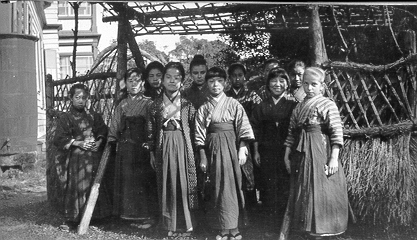
The primary age class at the
WUMS School in Yokahama, Japan, ca. 1895. From Collection 379.
New Year's eve we watched as the old year went out, and the
New came in. We had a testimony meeting, prayer and song. The time went very fast.
Back to Table of Contents
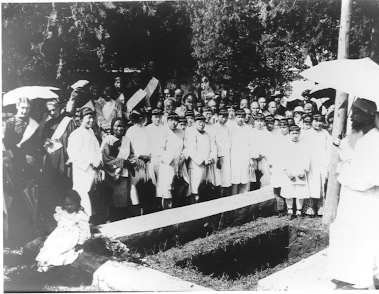
Burial of J. Hudson Taylor in China, June 1905. From Collection 215
Mind and Faith
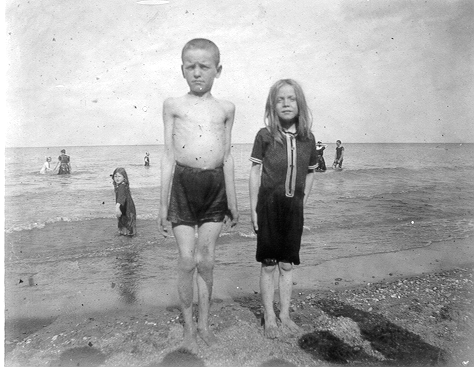
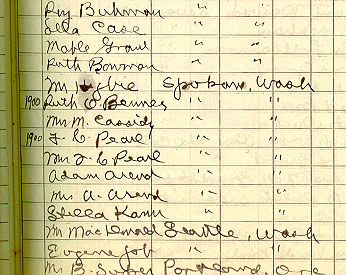
First page, from 1900, of the "Life Record" of minister Harry Ironside,
recording the baptisms and marriages he performed. From Collection 330.
Back to Table of Contents
Send us a message
Return to BGC Archives Home Page
Last Revised: 1/17/98
Expiration: indefinite
© Wheaton College 2005